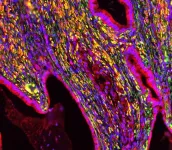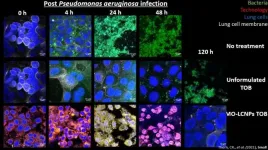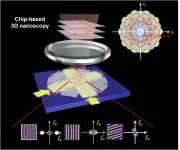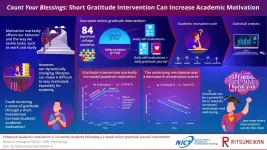Non-linear optics meets X-rays
2021-05-13
(Press-News.org) The relevance for radiology applications is probably the most known advantage of X-ray beams (keV energies) with respect to visible radiation (eV energies) and can be traced back to their superior penetration depth. On a more fundamental ground, however, the relevance of this photon energy range relies on the capability of probing inner shell electrons (as they have comparable binding energies) and mapping molecular structures on the atomic-scale (as typical interatomic spacings are comparable to X-ray wavelengths). Building on such capabilities, large efforts have been devoted by the scientific community to develop X-ray sub-picosecond sources able to access matter properties with a time resolution sufficient to access elemental molecular motions. Free electron lasers (FEL), nowadays available at several large-scale facilities around the world, represent a prime candidate to generate femtosecond X-ray pulses with high brilliance. One of the main challenges to exploit the enormous potential of FEL sources is developing methods for tuning the spectral and temporal beam properties, a task which is customarily achieved at visible wavelengths resorting to non-linear optics.
In a new paper published in Light Science & Application, a team of scientists from Italian Institute of Technology, University of L'Aquila, FERMI Trieste and "Sapienza" University of Rome have shown the first evidence of self-phase modulation (SPM) in the soft X-ray regime. The experiment, performed in the facility FERMI@elettra of Trieste, consists in the observation of spectral modulation after the interaction of focused FEL beams with a very thin metallic foil (100-300 nm).
"Our experiment demonstrates a new control knob for spectral shaping of FEL pulses. Blue to red shift accompanied by bandwidth increase can be obtained by moving the input wavelength across the material's absorption edge" prof. Tullio Scopigno explains.
The atomic absorption edges in the X-ray region feature sharp discontinuities: an optical transparent material can absorb light modifying the photon energy by less than 1%, correspondingly generating specific core electron excitations.
"This first observation of SPM effects in the soft X-Ray regime allows to unveil specific atomic properties on the subpicosecond time scale. In particular, the interplay with a light-induced out-of-equilibrium electron plasma generated on the femtosecond timescale in thin metallic foils." concludes Dr. Carino Ferrante.
Below the absorption edge, the observed SPM is induced by Kerr effect, i.e. by a modification of the non-linear refractive index mimicking the pulse intensity profile, which ultimately results into spectral broadening, accompanied by a redshift due to valence electrons heating. In striking difference, above edge, the highly excited core photoelectrons generated by the pulse leading edge form a transient hot dense ionized plasma, responsible for a sharp decrease of the refractive index. Consequently, the pulse trailing edge is accelerated giving rise to an asymmetric temporal compression which, in turn, results in a blueshift.
The results provide a proof of concept for spectral shaping of soft X-ray pulses, a key milestone towards the development of new protocols for femtosecond core electrons spectroscopies.
INFORMATION:
[Attachments] See images for this press release:
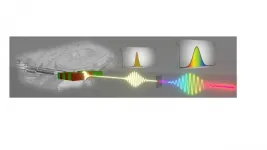
ELSE PRESS RELEASES FROM THIS DATE:
2021-05-13
UNSW medical researchers have found a way to starve pancreatic cancer cells and 'disable' the cells that block treatment from working effectively. Their findings in mice and human lab models - which have been 10 years in the making and are about to be put to the test in a human clinical trial - are published today in Cancer Research, a journal of the American Association for Cancer Research.
"Pancreatic cancer has seen minimal improvement in survival for the last four decades - and without immediate action, it is predicted to be the world's second biggest ...
2021-05-13
The Indian public blamed foreigners, minority groups and doctors for the rapid spread of COVID-19 across the country during the first wave, due to misinformation, rumour and long-held discriminatory beliefs, according to an international study led by Monash University.
This resulted in people refusing to get tested for fear of humiliation or public reprisals, which included attacks on Muslims and health care workers.
However, when presented with accurate and reliable information about the virus spread, the Indian public back-pedalled on those negative sentiments and were more likely to get tested and seek medical help, highlighting the importance of health advice from credible sources.
A ...
2021-05-13
World-first nanotechnology developed by the University of South Australia could change the lives of thousands of people living with cystic fibrosis (CF) as groundbreaking research shows it can improve the effectiveness of the CF antibiotic Tobramycin, increasing its efficacy by up to 100,000-fold.
The new technology uses a biomimetic nanostructured material to augment Tobramycin - the antibiotic prescribed to treat chronic Pseudomonas aeruginosa lung infections in severe cases of CF - eradicating the infection in as little as two doses.
In Australia, cystic fibrosis (CF) affects one in 2500 babies - or one baby born every four days - causing severe impairments to a person's ...
2021-05-13
Cancer death rates have fallen dramatically in the United States, but factor in obesity, as researchers did at the University of North Carolina Gillings School of Global Public Health, and the picture changes.
In a study published May 10 in JAMA Network Open, researchers showed that obesity-related cancer deaths are improving, but at a slowing pace.
Based on mortality data for 50 million people, deaths from cancers not associated with obesity -- that's lung cancer and skin cancer, among others - are declining at a rate almost three times faster than cancers linked to obesity, such as stomach, colorectal, uterine, thyroid and postmenopausal breast cancer.
"These are cancers where we could see even larger mortality improvements with creative and practical tools to combat ...
2021-05-13
Compared with the superresolution microscopy that bases on squeezing the point spread function in the spatial domain, the superresolution microscopy that broadens the detection range in the spatial frequency domain through the spatial-frequency-shift (SFS) effect shows intriguing advantages including large field of view, high speed, and good modularity, owing to its wide-field picture acquisition process and universal implementation without using special fluorophores labeling.
To enable spatial-frequency-shift microscopy with a superresolution at the subwavelength scale, it is essential to use the near-field evanescent wave with a larger wave vector than the far-field propagation wave for illumination, which can be built on the integrated photonics, paving the way for compact ...
2021-05-13
Researchers from Tokyo Medical and Dental University (TMDU), collaborating with scientists from the Marine Biological Laboratory (MBL) and RIKEN, develop a novel technique for live-cell fluorescent imaging which leads them to discover a new actin structure in starfish early embryos.
Tokyo, Japan - Monitoring alignments of the building blocks of cells is important to understand how the cells are built. By collaborating with imaging scientists at the MBL, researchers from Japan have developed a new probe which they call POLArIS, allowing real-time imaging of molecular orientations in live cells.
A fluorophore emits polarized light as it glows. The orientation of polarized fluorescence ...
2021-05-13
It is difficult for us to succeed in whatever we set out to do if we lack motivation. We usually need it as a driving force to achieve both short- and long-term goals, from household chores to getting a degree. However, because of the ongoing pandemic, our lifestyles have been subjected to drastic and dynamic changes, and many work- and study-related activities are now carried out online exclusively. This, among other complex factors, have made it difficult for some people to stay focused and motivated, and psychology researchers are trying to find effective and widely applicable solutions to address such problems.
In a END ...
2021-05-13
COLUMBUS, Ohio - A new study's findings dispel the misconception that patients and providers are at high risk of catching COVID-19 at the dentist's office.
SARS-CoV-2 spreads mainly through respiratory droplets, and dental procedures are known to produce an abundance of aerosols - leading to fears that flying saliva during a cleaning or a restorative procedure could make the dentist's chair a high-transmission location.
Ohio State University researchers set out to determine whether saliva is the main source of the spray, collecting samples from personnel, equipment and other surfaces reached by aerosols during a range ...
2021-05-13
Twenty-seven years ago, more than 1 million Rwandans were killed during the genocide against the Tutsi in Rwanda from April 7 to July 4, 1994. It is estimated that 100,000 to 250,000 women were raped during the 100-day genocide, and that 10,000 children were born as a result. A new study finds that Rwandans who were conceived by mothers who survived the 1994 genocide against the Tutsi have poorer adult health outcomes than those who were conceived by Rwandan mothers living outside the country at that time. In addition, those who were conceived through genocidal rape have poorer adult health ...
2021-05-13
DALLAS, May 13, 2021 -- Higher body mass index (BMI) in adolescence is associated with a significantly higher risk of first ischemic stroke in adults under age 50 regardless of whether they had Type 2 diabetes, according to new research published today in Stroke, a journal of the American Stroke Association, a division of the American Heart Association.
While rates of adolescent obesity and stroke among adults under the age of 50 years continue to rise around the world, the precise link between the two conditions is still not fully understood.
"Adults who survive stroke earlier in life face poor functional outcomes, which can lead to unemployment, depression and anxiety," said study co-author Gilad Twig, M.D., M.P.H., Ph.D., an ...
LAST 30 PRESS RELEASES:
[Press-News.org] Non-linear optics meets X-rays

